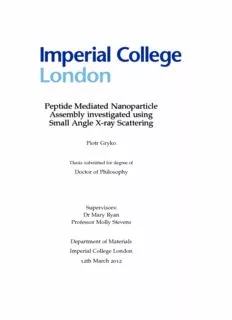
Peptide Mediated Nanoparticle Assembly investigated using Small Angle X-ray Scattering PDF
Preview Peptide Mediated Nanoparticle Assembly investigated using Small Angle X-ray Scattering
Peptide Mediated Nanoparticle Assembly investigated using Small Angle X-ray Scattering Piotr Gryko Thesis submitted for degree of Doctor of Philosophy Supervisors: Dr Mary Ryan Professor Molly Stevens Department of Materials Imperial College London 12 2012 th March PiotrGryko: PeptideMediatedNanoparticleAssemblyinvestigatedusing SmallAngleX-rayScattering,DoctorofPhilosophy, 12thMarch2012 Agoodtravelerhasnofixedplans andisnotintentonarriving —LaoTzu Toloveistorecognizeyourselfinanother —EckhartTolle ABSTRACT May you live Nanoparticle systems arranged through bio-chemical self-assembly in interesting mechanismsdisplaynovelelectronicandopticalcharacteristicsapplic- times abletobiosensing,tissueengineering,therapeuticsanddrugdelivery. -Ancient Metallic Nanoparticles such as those composed of gold or CdSe are Chinese pro- expected to replace standard chemical fluorophore due to their high verb optical scattering cross-section. The colloidal nature of nanoparticles necessitatestheengineeringofNPssurfacechemistrytocontrolparticle stabilityandassemblyorder.Thehighintensityofmodernsynchrotron sources,combinedwiththehighelectrondensitycontrastofmetallic NPs,allowsforfast,sensitive,in-situsynchrotronmeasurements.Here Small Angle X-ray scattering is used to observe nanoscale structural changesandrelatethemtochangesinpolypeptidemediatedinteraction potential,particlesurfacechargeandmobilitywithinaggregates.These results enable strategies for optimising the structure and the optical characteristicsofNPassemblies,whicharevitalfortheirperformance ascolourimetricsensors.HerethreeNPsystemsareinvestigatedand characterised: (1) Gold nanoparticles assembled using de novo designed poly- peptides developed by D. Aili (Chapter 3). The assembly is achieved by the folding dependent bridging of the particles induced by the heteroassociationofimmobilisedhelix-loop-helixpolypeptidesanda complementarynon-linearpolypeptidefoundinsolution.Changesin theopticalpropertiesoftheassemblyasafunctionofparticlesizeand linker concentration are observed, with SAXS used to obtain in-situ structural information on the aggregates. The particles are found to assemble into highly ordered close packed structures with an inter- particlespacingof4.8±0.4nm,correspondingtothelengthofafolded polypeptide.Changesinparticleordering,aggregationdynamicsand massfractaldimensionareobservedasafunctionoflinkerconcentra- tionandparticlesize.Thesetransitionsarerelatedtochangesinlinker mediated interaction potential, particle surface charge and mobility withintheaggregates. (2) Interaction of BSA with AuNP aggregates (Chapter 4). Bovine serumalbumin(BSA)isavitalcomponentofstandardimmunological assays and it is often extended for use in de-novo assays based on peptidemodifiedmetallicnanoparticles.Whilstawiderangeofplasma proteins such as BSA and HSA have been shown to associate with nanoparticles, there is little work done on the effect of BSA on NP assemblies,whicharehighlydependentonparticlestability.Herethe effect of BSA on AuNP aggregates is characterised, using stability assays, DLS, UV-VIS and SAXS. Far from being an inert component, the introduction of BSA directly alters the structure and interaction of AuNP aggregates. Temperature is observed to be a factor in these interactionswithaspecificaffinityforhydrophobicsystems. (3) A Quantum Dot - Gold Nanoparticle conjugate assay for the detection of urokinase plasminogen activator (uPA) (Chapter 5). Pro- teolytic enzymesare usedas diseasebiomarkers forseveralformsof cancer. The surface assembly of gold nanoparticles onto the surface of quantum dots is demonstrated, with the growth in conjugate size v characterisedusingin-situSAXS.Completeconjugatedisassemblyis observedupontheadditionoftheenzymeuPA,howeverQDslumines- cencedoesnotfullyrecover.Thisindicatesthatothereffectsmayresult inthepermanentquenchingofquantumdots. Theworkpresentedhereisdesignedtoguideinthesynthesisofgen- eralprinciplesforassemblyofNPsbybiomolecularmediatedbridging, whilstcontributingtothefundamentalunderstandingoftheassembly process. vi PUBLICATIONS TheworkdescribedinChapter3hasbeenpublishedinNanoletters: PolypeptideFolding-MediatedTuningoftheOpticalandStructural PropertiesofGoldNanoparticleAssemblies-DAili,PGryko,BSepul- veda,JDick,NKirby,RichardHeenan,LarsBaltzer,BoLiedberg,Mary P.RyanandMollyM.Stevens-NanoLetters,2011-ACSPublications Theworkpresentedinlaterchaptersiscurrently(asofsubmission) intheprocessofbeingpreparedforpublishinginresearchjournals. vii Acceptthefactthatnothingiscertainandnolawisfixed, beasfluidandformlessaswater, neverbetonstabilityorlastingorder. Everythingchanges. —RobertGreene[71] ACKNOWLEDGMENTS Iamextremelygratefulfortheextensivesupportandcheerfulenthusi- asmofDrMaryRyanduringthepastfouryears.Withoutyoursupport IwouldhavedroppedoutofthePhD;ithasbeenanhonourtowork withyou.IwouldliketothankImperialCollegeandProfessorMolly Stevens for the support and opportunity to study for a PhD and the EPSRCforfunding.Themultidisciplinarybiochemistryaspectsofmy workwerebasedontheexperimentalsystemsdevelopedbyDrDaniel Aili and Mr John Dick. Much of this thesis came from collaborative workwiththemandIamgratefuloftheirsupport. The opportunity to travel during my PhD provided experiences for personal growth and was immensely enriching. I would like to thanktheJapaneseSocietyforthepromotionofscience(JSPS)forthe opportunitytotraveltoJapanandDrTamotsuZakoandProfMaedafor theirhospitalityandexcellentscientificsupportattheRikenInstitute (Tokyo). All of the synchrotron measurements in this thesis were possible duetothehighperformanceSAXS/WAXSbeamlineattheAustralian synchrotron. The beamline scientists provided outstanding support, oftenworkingintotheearlyhoursofthemorning.Withouttheirhelp thisthesiscouldnothavebeenwritten. I would like to thank Prof Ian Robinson for his extensive supervi- sionduringmymastersprojectandsummerresearchinternship.Your supportencouragedmetopursueaPhD. Myclosefamilyandfriendshaveprovidedkindsupportoverthese years;thankyouKristinaforyourpatienceandlove. FinallyIwouldliketothankmyparentsfortheirstrength,loveand support over the decades. My achievements have grown out of your strengths. ix
Description: